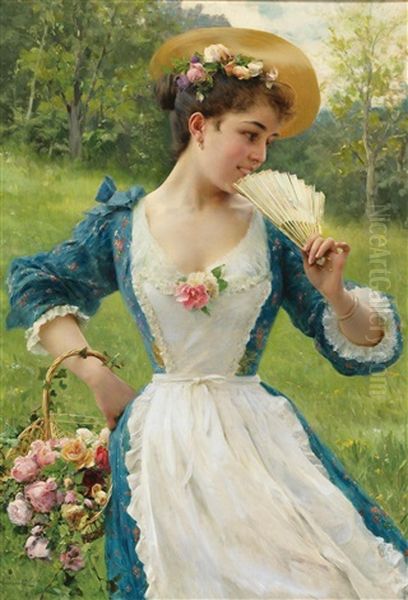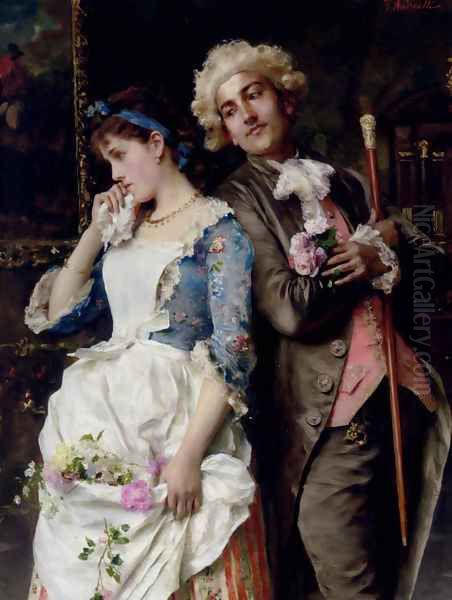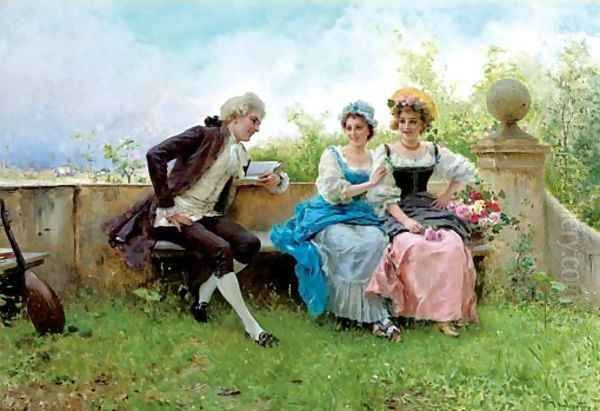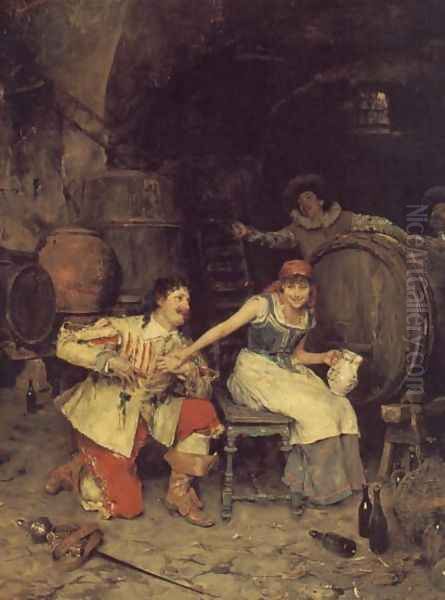
Federico Andreotti stands as a significant figure in late 19th and early 20th-century Italian art. Born in Florence in 1847 and passing away in 1930, Andreotti carved a niche for himself with his elegant depictions of historical genre scenes, particularly those evoking the spirit and fashion of the 17th and 18th centuries. His work, rooted in the academic traditions of his native city yet touched by contemporary artistic currents, continues to charm viewers with its technical finesse and nostalgic grace. He was primarily an Italian painter, deeply connected to the artistic heritage of Florence.
Early Life and Academic Foundations
Federico Andreotti's artistic journey began in the heart of the Renaissance, Florence. In 1861, he enrolled in the prestigious Accademia di Belle Arti di Firenze (Florence Academy of Fine Arts), a center of artistic learning that had nurtured generations of artists. There, he studied under the guidance of respected painters Enrico Pollastrini and Angelo Tricca. These instructors would have grounded him in the fundamentals of academic art, emphasizing draftsmanship, composition, and the study of Old Masters.
The environment at the Academy was crucial in shaping Andreotti's skills. He absorbed the lessons of anatomical accuracy and refined technique that were hallmarks of academic training. This solid foundation provided him with the technical mastery evident throughout his career. His time at the Academy not only honed his skills but also likely exposed him to the prevailing artistic debates and trends of the time, setting the stage for his later stylistic development. Eventually, his dedication and talent led him to become a professor at the very institution where he had trained, a testament to his standing within the Florentine art community.
Artistic Style and Thematic Focus

Andreotti's style is often characterized as a blend of Realism and Rococo Revival, sometimes termed Neo-Rococo. He possessed a remarkable ability to render figures and fabrics with meticulous detail, grounding his scenes in a tangible reality. However, his choice of subject matter frequently leaned towards the elegance and perceived frivolity of the Ancien Régime, particularly the 17th and 18th centuries. He specialized in depicting aristocratic life, showcasing figures in elaborate period costumes within richly decorated interiors or idyllic garden settings.
His paintings often feature charming narratives – a courtship, a musical interlude, a quiet moment of reflection, or social gatherings like afternoon tea. Women, portrayed with grace and beauty, are central to many of his compositions, adorned in silks and satins that Andreotti rendered with palpable texture and sheen. His palette was typically bright and cheerful, employing techniques that sometimes showed an awareness of Impressionist handling of light and color, though without fully embracing the Impressionist ethos. He skillfully combined this lighter touch with the solid draftsmanship learned at the Academy.
Andreotti demonstrated a deep understanding of historical costume and settings, using them to create evocative glimpses into bygone eras. His works were not merely historical illustrations but aimed to capture a mood of elegance, romance, and often, gentle humor. The overall effect is one of polished craftsmanship dedicated to themes of beauty and sophisticated leisure, appealing strongly to the tastes of collectors in the late 19th century.
Key Works and Recognition
Several paintings stand out as representative of Federico Andreotti's oeuvre and artistic preoccupations. A Young Beauty With A Basket Of Roses exemplifies his skill in portraying youthful charm and the delicate rendering of textures, from the softness of petals to the richness of fabric. The subject, a recurring theme of feminine grace associated with flowers, is handled with sensitivity and a keen eye for color harmony.
The Afternoon Tea captures a quintessential scene of aristocratic leisure, depicting figures engaged in conversation within a refined setting, likely a private garden. Such works reflect the social customs and aesthetic preferences of the upper classes that Andreotti frequently portrayed, offering viewers a window into a world of elegance and social ritual.

Another notable work, The Persistent Suitor, delves into the narrative potential of historical genre scenes. It likely portrays a scene of courtship, a common theme in his work, allowing Andreotti to explore human interaction and emotion within a meticulously recreated historical context. The attention to costume, setting, and gesture brings the 18th-century scene to life. Works like Key to the Heart and The Young Suitor also gained attention, showcasing his unique interpretation of classical and modern feminine beauty, and demonstrating his appeal in the art market. The Young Suitor, in particular, drew significant interest when it appeared at auction, praised for its technical skill and color.
Andreotti achieved considerable success during his lifetime. His paintings were highly sought after by European and American collectors who appreciated their decorative qualities and technical polish. His participation in exhibitions, including reportedly at the prestigious Royal Academy in London, helped solidify his international reputation and placed his work before a wider audience, confirming his status as a respected artist of his time.
Context and Contemporaries
Federico Andreotti worked during a period of diverse artistic exploration in Europe. While rooted in the academic tradition taught by figures like Enrico Pollastrini and Angelo Tricca at the Florence Academy, his style also reflected broader trends. His focus on historical genre scenes, particularly those with an 18th-century flavor, aligned him with the Rococo Revival movement, a nostalgic current popular in the latter half of the 19th century. This interest was shared by artists in other countries, such as Édouard Toudouze in France and Marcus Stone in England, who also specialized in elegant historical narratives.
Although direct evidence of specific collaborations or intense rivalries with major contemporaries is scarce in the provided information, Andreotti was undoubtedly aware of the artistic landscape. In Florence, he would have been familiar with the Macchiaioli group, including artists like Telemaco Signorini and Silvestro Lega, who pursued a very different path of Realism focused on contemporary Italian life and landscape, using patches ('macchie') of color. While Andreotti's style differed significantly, the emphasis on light and direct observation in Macchiaioli work might have subtly informed his own approach to color.

Internationally, his work can be seen in the context of other highly successful academic and historical genre painters like Jean-Léon Gérôme in France, known for his meticulous historical and Orientalist scenes, or Lawrence Alma-Tadema in England, famed for his depictions of classical antiquity. While Andreotti's subject matter was generally lighter, the shared emphasis on historical detail and narrative clarity connects them. Furthermore, his adaptation of brighter palettes and somewhat looser brushwork in certain passages suggests an awareness, if not an embrace, of Impressionism, perhaps absorbing lessons from artists like Auguste Renoir or Edgar Degas regarding the depiction of modern life and the effects of light, even while applying them to historical subjects. His contemporary, fellow Italian Giovanni Boldini, achieved great fame with dazzling society portraits, showcasing a different facet of depicting elegance in the same era. The French master Jean-Louis-Ernest Meissonier also excelled in small-scale historical genre scenes, though often with a focus on military or 17th-century subjects, representing another parallel strand of historical painting. Gustave Moreau, another French contemporary, explored symbolism with a very different aesthetic, highlighting the diversity of artistic paths during this time. Andreotti navigated these currents, developing his distinct, elegant style.
Later Career and Legacy
In his later career, Federico Andreotti solidified his reputation and continued to produce works characterized by their charm and technical skill. His appointment as a professor at the Florence Academy of Fine Arts indicates the respect he commanded within the established art world of his city. He passed on the traditions of academic training while embodying a style that had found significant favor with the public and collectors.
Evaluations of Andreotti's contribution sometimes note a potential limitation in his later focus. Some critics suggest that by concentrating primarily on pleasing genre scenes, portraits, and perhaps landscapes, he may have moved away from more ambitious historical compositions, potentially impacting his standing in the annals of 'high art' compared to artists tackling grander historical or social themes. However, this critique does not diminish the mastery he achieved within his chosen specialty.
His primary legacy lies in his contribution to the Rococo Revival style and his consistent production of high-quality, aesthetically pleasing paintings. He skillfully blended academic precision, particularly in rendering anatomy and detail, with a sensitivity to color and light that reflected newer artistic sensibilities. His work captured a sense of nostalgia for aristocratic grace and elegance that resonated strongly with the tastes of his time and continues to find admirers today. Andreotti remains recognized for his technical brilliance, his charming subject matter, and his role in popularizing a refined, historically-inspired genre.
Anecdotes and Nuances
While much of Andreotti's career seems defined by professional success and the creation of elegant artworks, hints of minor controversy or specific challenges occasionally surface, adding nuance to his biography. One account suggests that some of his works faced criticism regarding depictions of nudity. The details surrounding these specific instances, including which paintings were involved, remain unclear based on the available information.

However, it is reported that Andreotti met such criticism not with defensiveness, but with a degree of irony. Eventually, it seems he may have agreed to modify certain works to appease critics or conform to prevailing sensibilities. This anecdote, though lacking specifics, paints a picture of an artist navigating the sometimes-conservative social mores of his time, perhaps willing to compromise on minor points while maintaining his artistic integrity. It suggests an artist aware of his audience and the potential reception of his work, capable of responding with wit to critiques. Such incidents highlight the complex relationship between artists, their creations, and public or critical opinion, even for a painter primarily known for charming and non-confrontational subjects.
Conclusion
Federico Andreotti occupies a distinct and respected place in Italian art history. As a product of the Florentine Academy, he mastered the rigorous techniques of academic painting. Yet, he adapted these skills to create a body of work characterized by elegance, charm, and a nostalgic look back at the fashions and manners of the 17th and 18th centuries. His contribution to the Rococo Revival style was significant, and his paintings, filled with graceful figures, rich costumes, and pleasant narratives, found widespread appreciation among collectors in Europe and beyond.
While perhaps not an avant-garde innovator in the mold of the Impressionists or Macchiaioli, Andreotti excelled within his chosen genre. He skillfully blended meticulous realism with a lighter, sometimes Impressionist-influenced handling of color and brushwork. His ability to evoke a sense of refined leisure and historical romance, combined with his undeniable technical proficiency, ensured his success during his lifetime. Today, his works continue to be admired for their beauty, craftsmanship, and their evocative portrayal of a bygone era, securing Federico Andreotti's legacy as a master of Florentine elegance and historical genre painting.